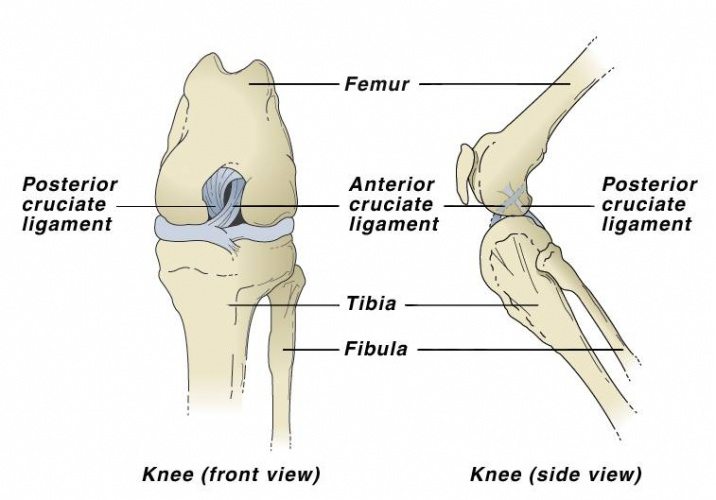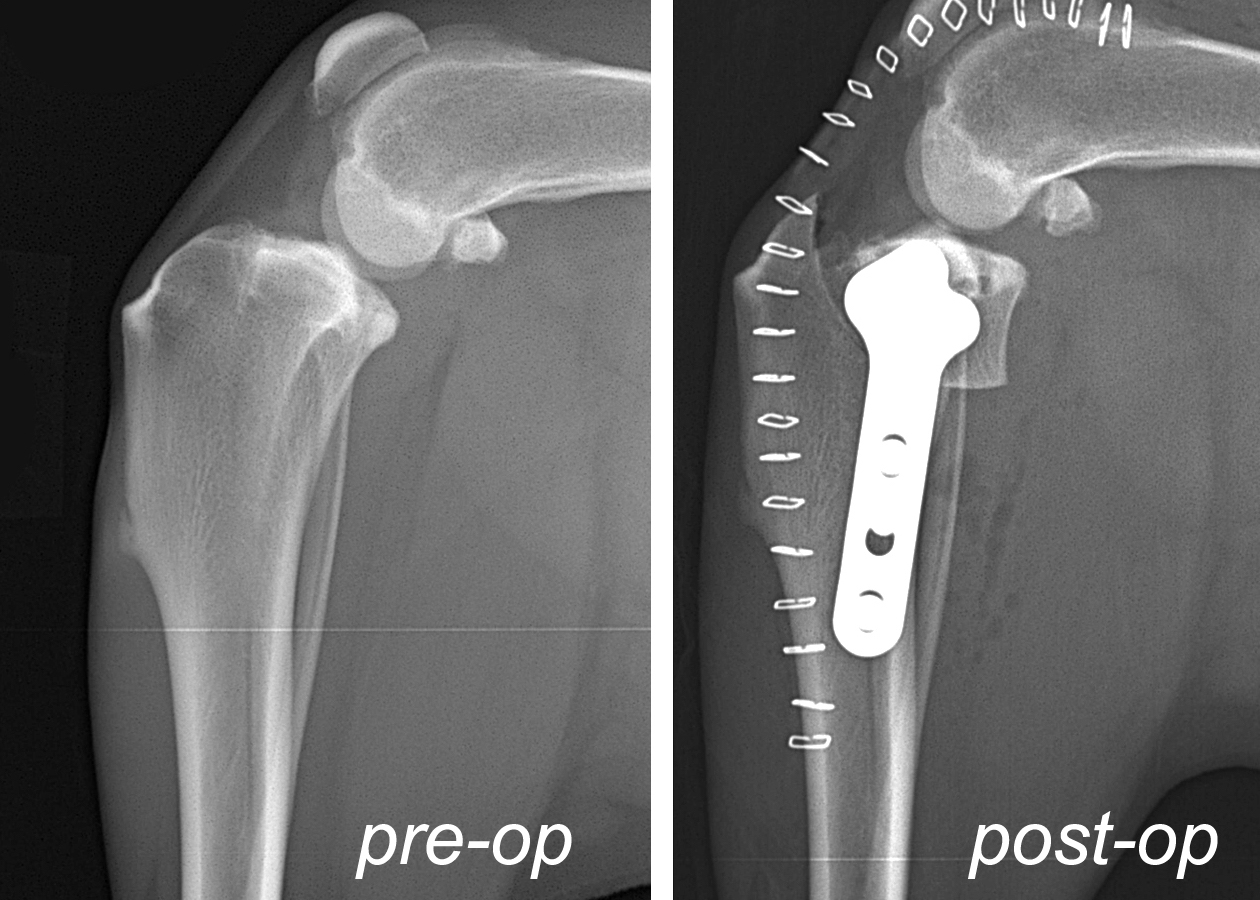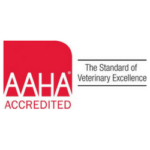Tibial Plateau Leveling Osteotomy (TPLO) Surgery
Credit: Mark Anderson, BVMS, edited by the CAHWC 12/2017
Understanding Cranial Cruciate Ligament (CCL) Injuries in Dogs
There are two primary ligaments inside the knee that control movement between the femur and the tibia: one is called the caudal cruciate ligament, and the other is called the cranial cruciate ligament (CCL) (analogous to the human ACL, or anterior cruciate ligament). In both species, the CCL/ACL is prone to tearing, resulting in a partial and complete rupture. After partial or full rupture of the CCL, the excessive motion between the femur and the tibia leads to pain, inflammation and swelling of the joint, cartilage damage, and osteoarthritis.
Dogs with a partial or complete tear of the CCL will usually be quite lame in the acute stages of the disease, which will improve somewhat over time. This does not, however, mean that the CCL is healing, as damage to the CCL is not reversible. Once the fibers begin to tear, instability of joint ensues, which will only continue to progress with time. Surgery is required to correct the condition and to improve your pet’s comfort.

Multiple studies have repeatedly shown that in both the immediate (initial days to weeks) and long-term (months to years), dogs do significantly better with surgical repair versus medical management of CCL rupture.
There are three different commonly used surgical repair techniques: the Tibial Plateau Leveling Osteotomy (TPLO), the Tibial Tuberosity Advancement (TTA), and the extracapsular suture repair.
Tibial Plateau Leveling Osteotomy (TPLO)
The TPLO corrects the effect of the torn CCL by re-orienting the tibial plateau (the top of the tibia) in a more level position. This eliminates the excessive fore and aft motion and force of the femur relative to the tibia (called cranial thrust). The simplest model that explains this well is the “Wagon on the Hill” example: Imagine a wagon (the femur) connected to a post on a hill (the tibial plateau) by a rope (the CCL).

As the angle of the hill increases, the greater the load on the rope (CCL). (One theory is that this excessive load—plus a collagen defect in the ligament itself—leads to rupture.) Thus, if the angle of the hill is the tibial plateau angle, and if this angle is eliminated (or nearly eliminated), the excessive force on the rope (CCL), and other critical parts of the joint (e.g., the meniscus), is eliminated or greatly reduced.
The TPLO procedure essentially flattens the tibial plateau angle to eliminate these damaging forces in the knee. As you can see in the radiographs, the tibial plateau angle after surgery is nearly horizontal, compared to the significant slope prior to surgery. The TPLO does not replace the damaged CCL, but it drastically reduces the need for it by correcting the tibial plateau angle.
Tibial Tuberosity Advancement (TTA)
The TTA corrects the torn/partially torn CCL by changing the direction at which the quadriceps (thigh muscles) pull. The pull of the quadriceps not only straightens the knee, but it also tends to pull the tibia forward (cranial thrust). Studies have shown that if this pull is directed at 90 degrees to the tibial plateau then the tendency to pull the tibia forward is eliminated. The TTA accomplishes this by moving the attachment point of the quadriceps tendon on the tibia forward.

Extracapsular Suture Repair
This procedure represents the long-standing traditional surgical repair for CCL rupture. Instead of having to perform an osteotomy (cutting of the bone, as with both the TPLO and TTA), this procedure relies on the placement of strong suture material around the flabella (behind the knee) and through a hole in the tibia, to replicate the stabilizing force the torn CCL can no longer provide the joint.
TPLO vs TTA vs Extracapsular Suture Repair
All three of these surgeries may produce excellent outcomes, and have situations where one may be preferred over the other. It generally believed, however, that the more active and larger the pet, the better they will do, in both the short and long term, with a TPLO or TTA. However, there is no consensus among surgeons, or consensus of data for that matter, as to whether the TPLO or the TTA is inherently superior. That being said, there are situations in which one procedure may be better suited than another for anatomic reasons, to correct concurrent problems (i.e., luxating patellas, femoral bowing, etc), pet lifestyle, or even client budget! As such, we assess each pet individually, and work with you to select the most appropriate procedure based on your individual pet, your goals, and the existence of other concurrent orthopedic or medical conditions.
Recovery and Rehabilitation
While every case is unique, most of the dogs that undergo TPLO/TTA surgery are able to walk out of the hospital the same day of surgery. A limp will still be present, but the vast majority are at least toe touching. At time of your pet’s discharge from the hospital, we supply you with detailed recovery and rehabilitation instructions. If at any point during the post-operative recovery and rehabilitation process you have any questions or concerns, we will be available to you. We are very responsive to all of our clients, and motivated to resolve any concerns you have regarding your pet’s recovery, as we are fully aware that great outcomes have everything to do with attentive follow-up.
AAHA Accredited Hospital & Fear-Free Certified Professionals
Further supporting the excellent surgical care your pet will receive at the Cardiff Animal Hospital & Wellness Center, you may have full confidence that we are one of the only 12-15% of veterinary hospitals in the US and Canada that have achieved AAHA Accreditation. This means that we have committed to the highest standard of care in veterinary medicine, and adhere to over 900 established standards, thereby passing rigorous routine comprehensive on-site evaluations. We are exceptionally proud of our accreditation, knowing that it represents the elevated quality of care that we provide to your pet.
Additionally, we have taken the extra step to have our staff go through voluntary training for Fear-Free Certification. This means that we are pride ourselves in being dedicated to caring for your pet’s emotional well-being, as well as their physical well-being, while they are in our care.
Have a Question?
We're here to help! Please complete the form below and a member of our team will get back to you as quickly as possible. If you'd like to schedule an appointment or have an urgent matter, please call us at 760-436-3215.







